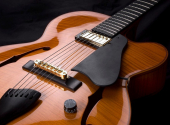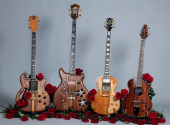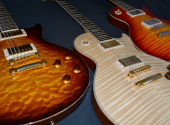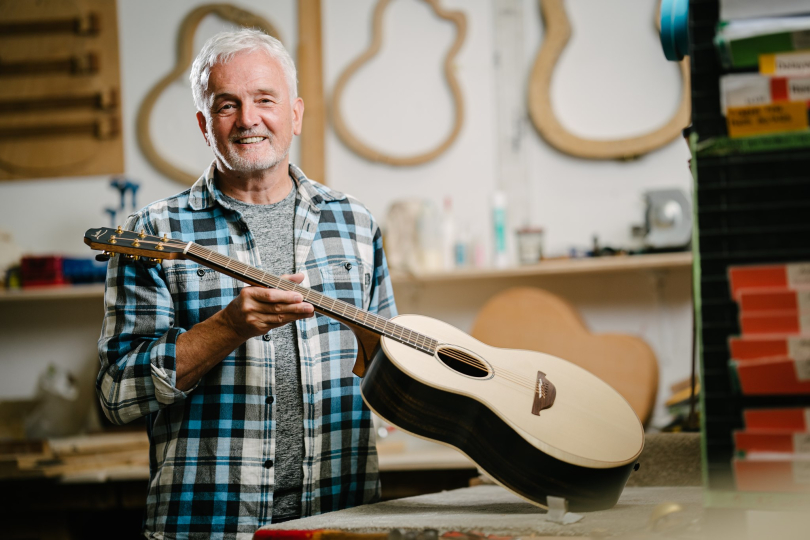
Legendary and Mythical Guitars #3: Lowden Guitars
Today's episode of the guitar series might be a little controversial. That's because its protagonist is surprisingly often the subject of heated debates among people in the guitar business, as well as players looking for unusual instruments. Both praised and reviled, but always breaking out from the average and conformity. This is Mr. George Lowden.
First meeting
The year was 2018 and I was carrying Halabica guitars from my car (I'll talk about them in a future episode) to the booth at the Holy Grail exhibition of exclusive handmade guitars in Berlin. I was helping Otto Halabica with his presentation at this iconic show and as I was busy preparing the display, I didn't pay much attention to my surroundings.
However, I couldn't miss the best-placed exhibitor area right at the entrance to the hall, which I passed back and forth several times. It had the Lowden logo on the wall, and I wondered what one would have to be or do or possibly pay to have that particular spot. During the show, a short-cropped, fair-haired gentleman was sitting at a booth with a lady his age. We guessed she was his wife. She didn't look like a secretary or a spokeswoman. Otto then told me that the gentleman was George Lowden from England and that he was well known.
He's actually from Northern Ireland. And he's definitely famous. Later I understood why. There were several very good-looking guitars in beautiful satin (natural) finish on the display stand and the couple of exhibitors were friendly and willing to answer questions. They gave the impression of a modest little family business, with Dad tinkering with his guitars and Mum helping him with the paperwork.
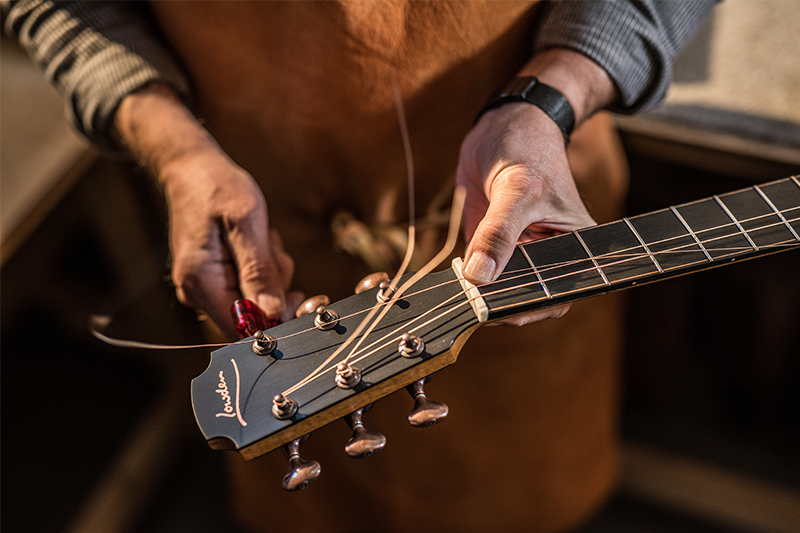
What else would they be anyway? Holy Grail was an exhibition of small guitar makers where mass producers had no place. To participate, you had to exhibit handmade, individually crafted guitars with a certain amount of originality and innovation. The usual annual output of exhibitors was a few pieces or at most a few dozen guitars. That is why the whole exhibition was designed in order for these "soloists" to be able to afford to take part – exhibiting at globally important events often implies crazy and unrealistic expenses.
All the more surprised I was when I was setting up my booth at the NAMM Show in Anaheim a few months later, and as I looked around to see who was in the neighbourhood, the familiar Lowden logo flashed in front of my eyes along with the names Collings and Ortega. I must have been dreaming, I thought. I took a better look and saw a booth the size of a small playground and another one across the aisle that had the Sheeran by Lowden logo. Both were swarming with a large team of maniacs in black polo shirts bearing the emblem of their Northern Irish employer.
Somehow it didn't seem right, so I asked a couple of my more experienced colleagues in the guitar business what they thought of the whole thing. They said something like, "Yeah, George. Boy, you can't be surprised." Steve McIlwrath, a former associate of Lowden's from Avalon Guitars, whom we met at the bar that night, added the icing on the cake. He said he was sure to publish a memoir, and it would be called Guitar Wars, about his lifelong financial and legal war with George Lowden.
Well, I wasn't there when they were starting a business together, manufacturing something and later fighting over it all. So I'm far from making personal judgments. What is certain, however, is that George Lowden is definitely not one of those quiet people who would tinker away in their backyard workshop with their instruments, not caring about the world around them, and conversely, the world not caring about them, as it seemed when I first met him in Berlin.
A bit of history
George Lowden was born in 1952 in Northern Ireland. All the self-referential texts say that he and a friend built their first two guitars when they were ten years old. Lowden senior was a boat builder, so his son probably already knew something about woodworking from home. The guitars were said to be box-shaped, with bent nails for frets and fishing lines for strings. Anyway, they made the young George discover his fondness for building guitars, and so he decided to make a living out of it. At the age of twenty-two, he founded Lowden Guitars and made a guitar with serial number one.
Later, the first employees joined him and the company took off. Licensed guitars were produced under his name in Japan in the 1980s. With the help of an investor, he then bought a building in Bangor, Northern Ireland, and took on more staff. His guitars already had a good reputation in terms of construction and quality, yet the company was struggling financially and was unable to achieve much commercial success. So George decided to join forces with Steve McIlwrath and a third partner, Alastair McIlween, and together they formed a majority-owned holding company, Lowden Guitars, to financially support Lowden's guitar production. Later they renamed themselves Avalon Guitars and then back to Lowden and so it all got properly muddled.
And that's when the years-long feud between George and Steve began. The original idea was that Avalon Guitars would own the Lowden brand, which George would design guitars for, as well as oversee their production and receive a royalty for lending his name. But then a battle ensued over the use of the Lowden brand name for commercial purposes on a worldwide scale and over whether or not and how George designed guitar models for Avalon.
It was obvious from the beginning that he had completely different intentions with his trademark than to serve Avalon. How far he got it legally clean is up to the judges to decide. But in any case, it sparked several lawsuits, protracted tussles that virtually never ended in a clear victory for either side. Even in this situation, however, Lowden didn't dawdle, and in 20004 began producing guitars under his own brand name in Downpatrick, Northern Ireland, and has been selling them all over the world ever since.
Dolphin bracing and manual paint scraping
Lowden guitars are different from the products from American manufacturers in the same price range. They have a more "wooden" and "round" look to them. This is mainly due to the natural look of the lacquer, the absence of any superfluous design "frills" and the rounded shapes of all body types.
There are several different ways to achieve the look of natural matt wood even after varnishing. For example, by ultra-thin coating, lacquer with an added matt component, polishing, etc. But Lowden has his own unique method: he sprays the body with a layer of lacquer (the composition of which he keeps to himself, but it is believed in the industry to be acid-catalyzed nitrocellulose) and then hand-scrapes it with steel wool. The fine scratches create the desired satin effect and a surface that is pleasant to the touch.
Another characteristic element of Lowden guitars is something that is not visible at first glance – their unique bracing. The basic A-shaped bracing pattern is hand-profiled into a "dolphin back" shape, varying according to the top plate material and body shape. The manufacturer claims that this is the secret to the unique Lowden sound, alongside, of course, the carefully selected materials and precise craftsmanship.
Anyway, the guitars not only have a sound that is very well balanced across the frequency spectrum but also a considerable amount of responsiveness (i.e. speed of response) and a different character of sound depending on the style the player is using.
The overall proportion of handwork on Lowden guitars is pretty high compared to his direct competitors, so the "handmade" claim could be considered justified in this case (unlike many others who use it for marketing reasons).
So what have you got there, Mr. Lowden?
Prodejní sortiment tvoří osm základních modelů a pak je tu kategorie modelů speciálních. Pokud mrkneme na jednotlivé kategorie, najdeme tato typová označení:
Original Series
The O is a model that follows in the tradition of Lowden's first guitar from 1976. It comes in several body sizes and for the ribs and back, you can choose between mahogany, rosewood, walnut and koa, combined with a spruce (sitka) or cedar top.
35 Series
The model series offers, among other things, a unique wood used for the back and ribs called "chechen". This is a material also known as black poisonwood and it comes from Central and South America. The top board is made from other varieties of spruce (adirondack, alpine) and sinker redwood (also known as redwood).
50 Series
The 50 series contains other interesting materials, including exotic woods such as African blackwood (also known as grenadilla), swamp oak, ebony and cocobolo. Top plate materials include redwood in addition to the standard spruce and cedar.
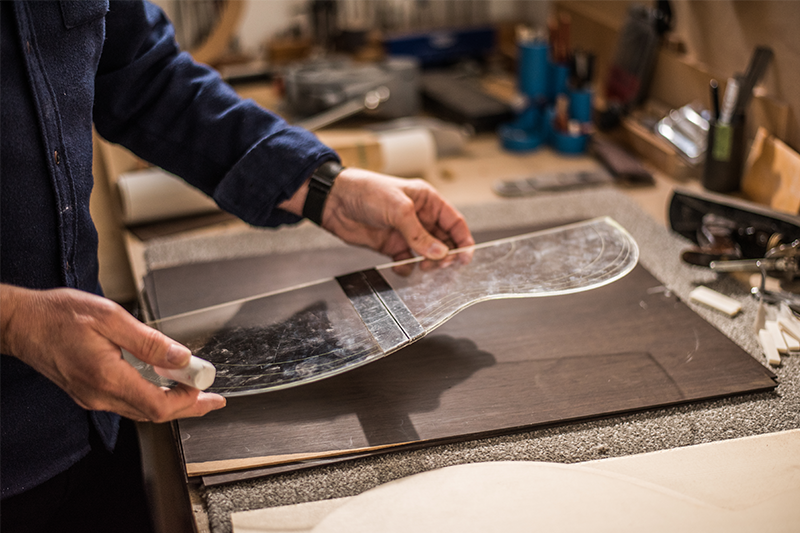
Jazz
This is not a model for gipsy jazz, as the name might suggest. Rather, the guitars in this series resemble a classical concert guitar. A wider neck, which suits players used to nylon strings, and a round, warm sound form the essential features of this series. The top is made from alpine spruce or cedar and rosewood, koa or walnut are used for the ribs and back. Guitars in this series are also available with nylon strings.
Special models
In this section, we can discover very interesting pieces which don't fit into the other categories. For example, a full-nut or full-mahogany model, a baritone guitar, guitars with a narrower body profile, guitars with a shorter scale and a number of anniversary, limited and signature models.
GL-10
Lowden also produces several models of electric guitars under the GL-10 name. The same interesting woods found on acoustic guitars can be found on electric ones. Walnut, koa, ziricote, mahogany, ebony, blackwood. All this in a very rounded design reminiscent of a Lowden acoustic guitar and in solid body or semi-hollow versions. The pickups are either humbuckers or P-90s from Lollar.
As with most high-end manufacturers, all Lowden guitars are available in a number of modifications. Whether it's materials, cutaway, bevel, left-handed or 12-string options, neck width and profile, pickup type, etc., the manufacturer tries to accommodate as much as possible.
Another common feature of these instruments is the use of very subtle natural materials for the binding, purfling and rosettes. If mother-of-pearl is used, it is only in a thin line. Exotic woods clearly predominate. Lowden uses Gotoh tuning machines on all guitars.
As for the guitar shapes, the Lowdens are called WL, S, F and O – in order of size from smallest to largest. That means a completely different name to what we're used to from most manufacturers. Plus, you won't find familiar shapes like a dreadnought, a grand auditorium and the like. With a bit of exaggeration, you could say that Lowdens are all equally round, just smaller or bigger.
Sheeran by Lowden
An interesting phenomenon in the history of Lowden guitars that can't go unmentioned is the creation of the Sheeran by Lowden brand in 2019. Yes, it is indeed the surname of a rusty little big man from the songwriting scene. Whether the sincere desire of the master songwriter and master guitar maker to support the superstar's young followers by creating an affordable guitar was the main motivation for the joint project, I have no idea. At least that's what the marketing claims. A calculated marketing ploy is another possible explanation.
Either way, these are small-sized guitars with the essentials you need to make the guitar play, but without paying for anything you don't need. Two basic model lines, a couple of speciality models, and retail prices of around 20k. Well, why not? Fans (especially female fans, according to the sales figures) of the singer-songwriter genius will surely enjoy the Sheeran inscription on the headstock of the guitar.
Even so, discussion forums on the subject are full of contradictory reactions. First of all, the guitar world points to the devaluation of the Lowden name, because the quality of Sheeran's guitars is very far from the Lowden standard. But as is often the case with George Lowden, there is at least something to talk about.
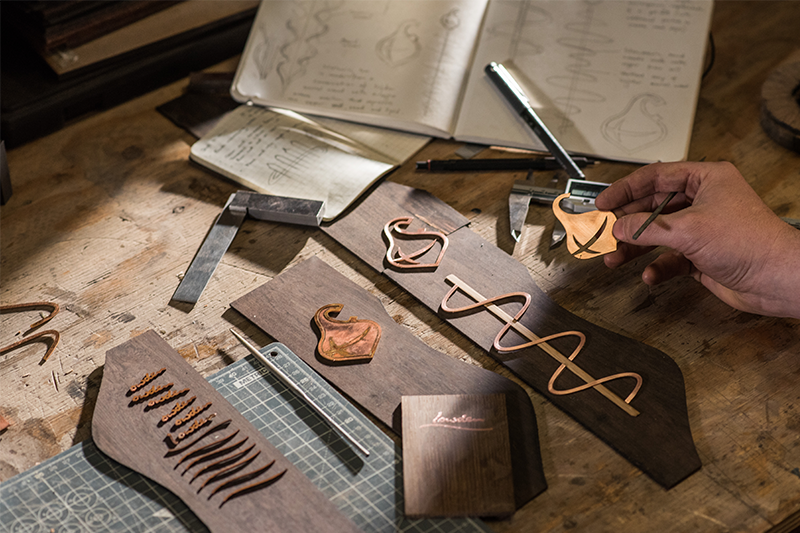
Where and for how much
Disregard the distribution of the Sheeran guitars, we can find dealers selling the "real" Lowdens in most Western European countries, with for example BTM Guitars in Nuremberg offering a selection of Lowden Guitars priced at 4-5,000 euros. That's more in the lower price range for the brand. In the UK or the USA, we can find guitars for sale that sometimes go over 10,000 euros in price.
The biggest seller of Lowden guitars is reportedly Heartbreaker Guitars, located just outside Las Vegas, Nevada. They are great people and the whole company is a role model of how a guitar dealer should operate, from expertise to service. I guess George knew how to make things work out for him.
Who's playing it
In addition to Ed Sheeran, Lowden guitars are played by other notable artists. Eric Clapton, Taylor Swift or Mark Knopfler could rival Sheeran in popularity. But then there are a number of excellent, but less-known guitarists who swear by Lowdens. Take American finger stylist Alex De Grassi or Fairport Convention's Richard Thompson, who can be found on hundreds of recordings, including albums by Crowded House and Bonnie Raitt. Or French-Algerian phenomenon Pierre Bensusan and Irish guitarist Paul Brady.
To conclude
George Lowden, by his very nature, seems destined to attract attention and provoke controversy and heated debate. But he certainly can't be denied his ability to design and build guitars of first-class quality, and to dare to work with materials that many other manufacturers are afraid to use. How come that Lowden's instruments always sound good? They say that the construction of the guitar is the most important thing, while the material is also important, but a close second. And what's in the third place? The quality of the workmanship, which is something that Lowden definitely excels at as well.
If you have found an error or typo in the article, please let us know by e-mail info@insounder.org.


